
This coming Monday, on April 21st, the First Family will host the 136th annual White House Easter Egg Roll. In addition to Easter Bunny appearances, speeches and bunny-centric book readings by deadpan politicians, children get to see who is fastest pushing a decorated egg through the grass with a long-handled spoon. It sounds like a spectacular event, though I can think of a thing or 17 I’d rather do with eggs around Easter then chase after them hunched over like Quasimodo.
Eating them immediately comes to mind, for instance.
And I wouldn’t be the first. People have been eating eggs to commemorate springtime since before the birth of Christianity. Ancient Egyptians, Persians, and Romans regarded them as a symbol of new life and fertility and included them in their Spring festivals. This cultural imprint runs deep, as exemplified by that favorite old Latin proverb, you know the one, “omne vivum ex ovo,” or “all life comes from an egg.”

For this reason, eggs became a symbol of deprivation in Medieval times during the strict Lenten fast. Instead of eating this forbidden food, people kept themselves busy by painting and decorating them for gift-giving. By the time Easter rolled around, everyone had a real hankering for these now extremely bountiful ovals, which helps explain their prominence in festivities.
Nowadays the whole ‘thou shalt not eat eggs during Lent’ rule has been largely set aside. And many cultures continue to have celebrated egg dishes, prepared exclusively around Easter time.
I grew up with one in particular, a flaky and savory pie called Torta Pasqualina, which means ‘Easter cake.’ My mom’s friend Adriana introduced my family to this delicacy and we became hooked the moment we tasted that scrumptious first slice prepared by her expert hands. Luckily for us, Adriana was originally from Genoa, Italy, and the Genoese are known for their culinary excellence.
(As a quick aside, the Genoese are also known for being remarkably frugal… read cheap here! An old, classic joke reflects this beautifully by depicting an elder Genoese man sitting at a coffee bar with a friend who offers to put sugar in his coffee. When asked how many teaspoons he’d like, the man answers: “Three please. At home, I use just one. Out, I use three. But I would love it so much with two.” And there you have it.)
The original version of this pie also had a crust made of 33 separate layers of super thin dough. Lest you think this number sheer insanity, allow me to explain that each layer symbolized a year of Jesus’ life and that versions with fewer layers were certainly acceptable. Years ago, Italian housewives amiably attempted to outdo each other with these layers of dough. Yes, those women with the ability to roll out the thinnest sheets of dough were able to make pies with the most layers and thus got to hold their heads the highest around town for a few days.
Only the diehards persevere in this effort. Most people who still roll out the dough have sheared the number of layers to a more manageable 6 to 18. While it is less symbolic, it is infinitely more practical. Or, if you’re like me, you can just buy filo dough and call it a day. It works beautifully, providing a most satisfying flaky crust and satisfying crunch. It also makes preparing this dish a manageable kitchen project that still allows you time to meet a friend for coffee or to walk your dog.
Now, this dish does require using a generous amount of butter: a whole stick for brushing on the filo and three tablespoons for the filling to be exact. The savory richness of this dish is exactly what makes it a special occasion dish. I mean, we wouldn’t eat Thanksgiving’s marshmallow-smothered, butter-dotted sweet potato casserole every day, though it sure is fun to devour in late November.
Besides, it gives us an awfully good reason to run in that neighborhood Easter egg roll race.
So I guess if we’re going to run in the race, we better have the tastiest of reasons then…like this treasured tradition in many parts of Italy during Easter. Eat it either warm or at room temperature…just eat it! If you have access to fresh swiss chard, I recommend using it. The ones I saw at the market on the day I made this dish looked sad, so I opted for spinach instead. You can’t go wrong any way you make it!
making torta pasqualina
Prepare 500 grams of fresh baby spinach or swiss chard by washing it well. Click here for how to blanch spinach. Place it in a skillet over medium heat and cook until wilted. You may need to do this in two batches if you’re using a 10-inch skillet. Drain, allow to cool, and then squeeze any water out of them with your hands.

Chop finely.

Heat 3 tablespoons of butter in a fying pan and add 1 small chopped onion.

Cook until soft, on medium heat, for 15 minutes. Add a little salt to taste and mix well.
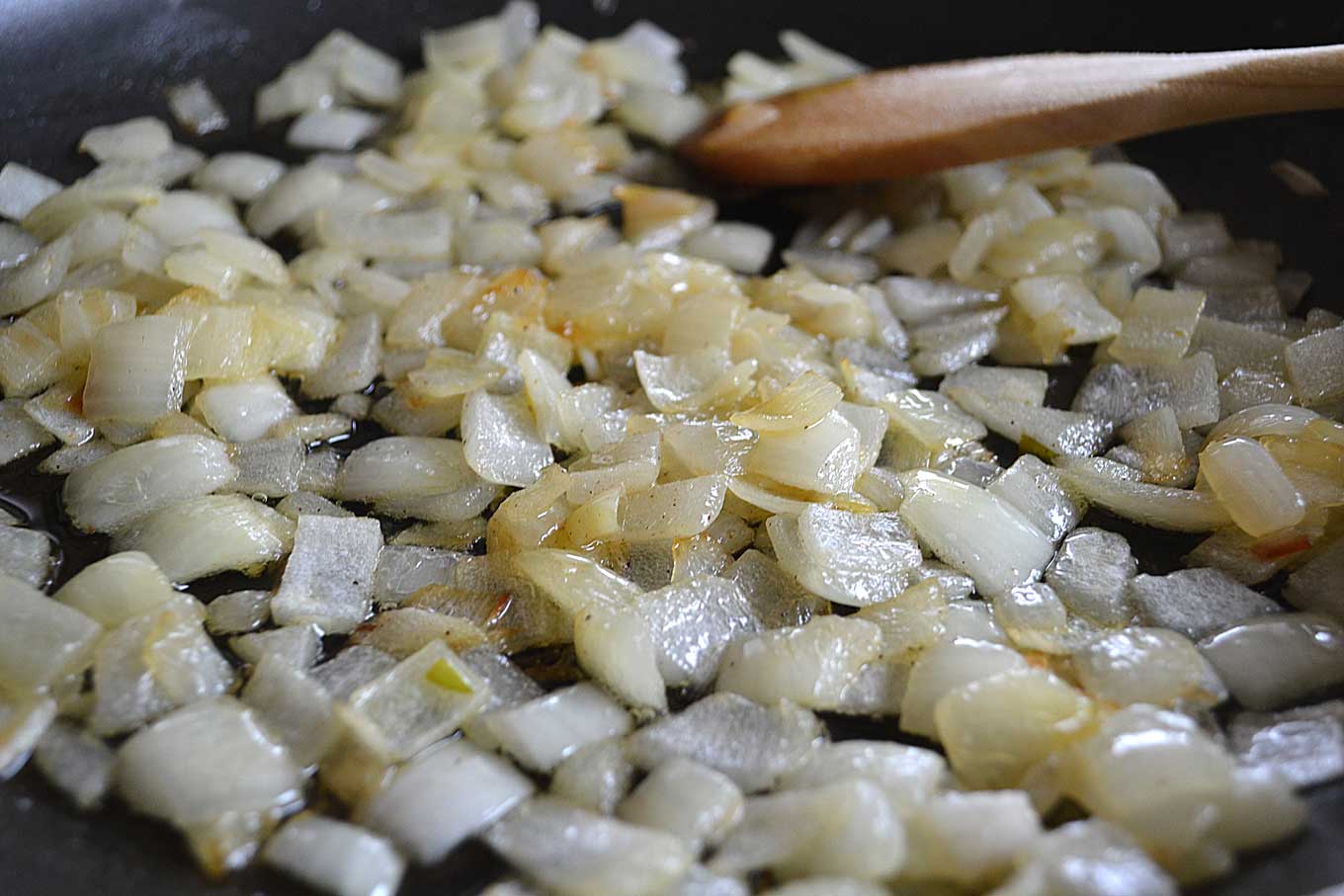
Remove from heat, add the chopped spinach, mix well and transfer to a large bowl.

In the same bowl as the spinach and onion mix, add the 1 2/3 cups of ricotta, a generous half cup each of Parmigiano-Reggiano and Pecorino, two whole eggs, 2 teaspoons of (preferably fresh) ground nutmeg, and salt and pepper to taste.

Don’t add too much salt, since the Parmigiano and Pecorino already lend a lot of saltiness. Mix well with a spoon and taste for seasoning.
Preheat the oven to 375°F and melt 1 stick of butter in a Pyrex measuring cup for 45 seconds in the microwave until completely melted. Remove the filo dough sheets from their packaging.
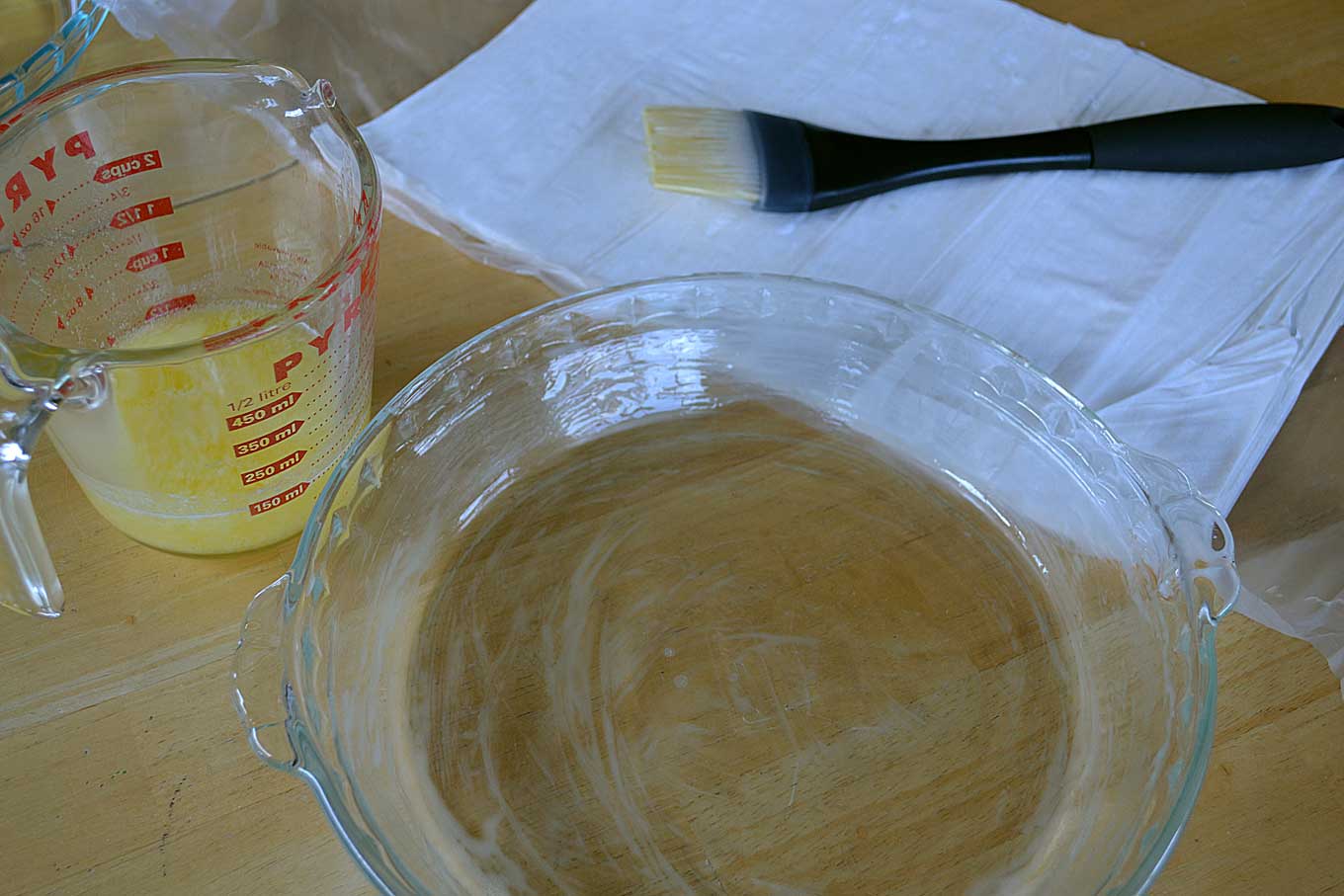
With a kitchen brush, butter a 10-inch pie dish. Open up 1 packet, or half, of a 1 lb. package of filo pastry and carefully unroll the filo sheets. Lay a sheet of filo over the buttered dish.
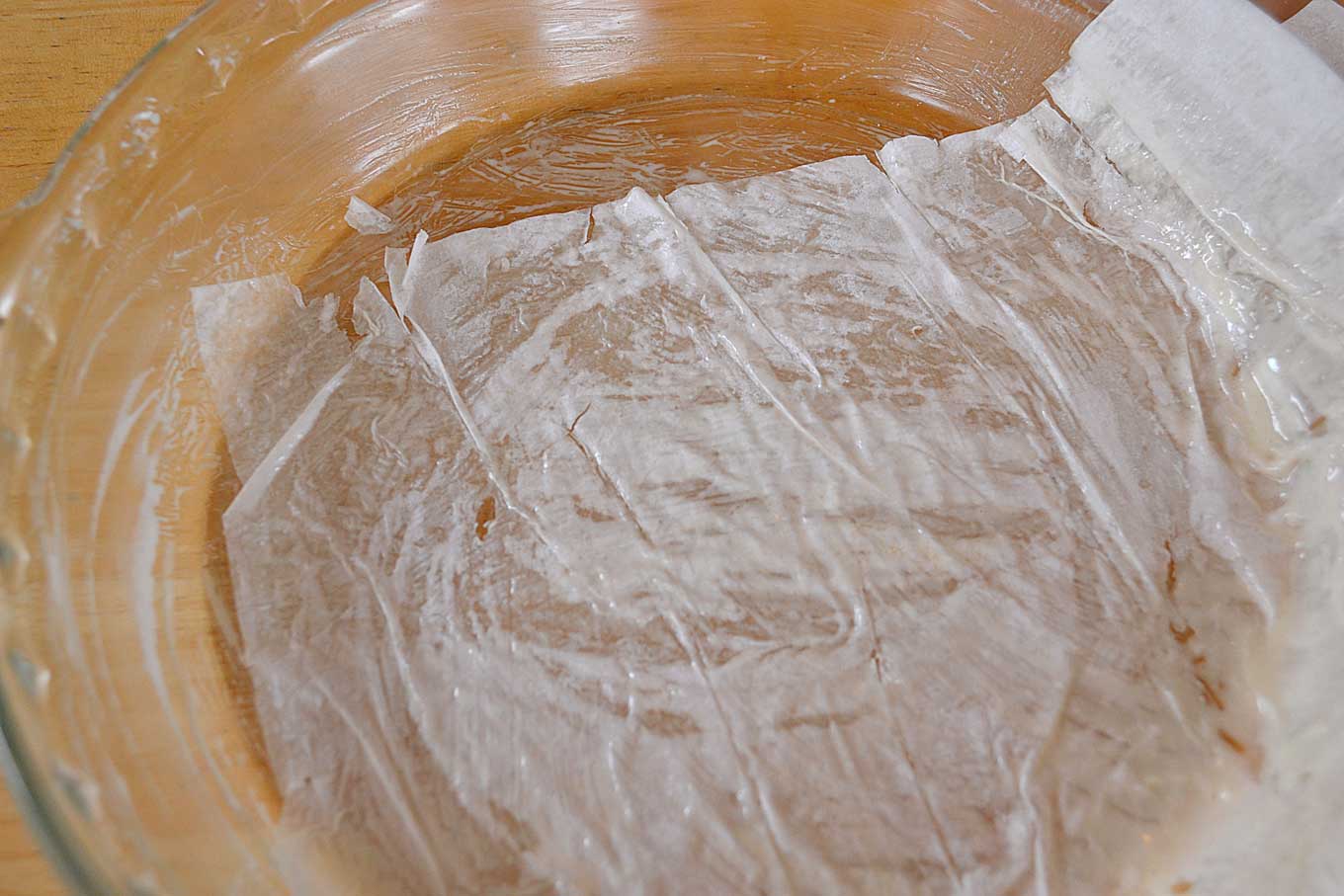
Instead of laying it centered over the dish, lay it to the side so that excess filo hangs over only one side of the dish. Brush lightly with butter.
Lay another sheet of filo on top at a slight angle to the first one.

Brush it with butter and lay a third sheet.

Butter that. Continue in this manner, with up to 12 or 20 sheets, brushing between sheets and working clockwise to lay each at a slight angle to the previous sheet.
When you are finished, it should look like this:

Transfer the spinach and ricotta mixture into the filo-lined dish. Spread out evenly. Using the back of a spoon, make six indentations in the filling.

Place 6 egg yolk in each.
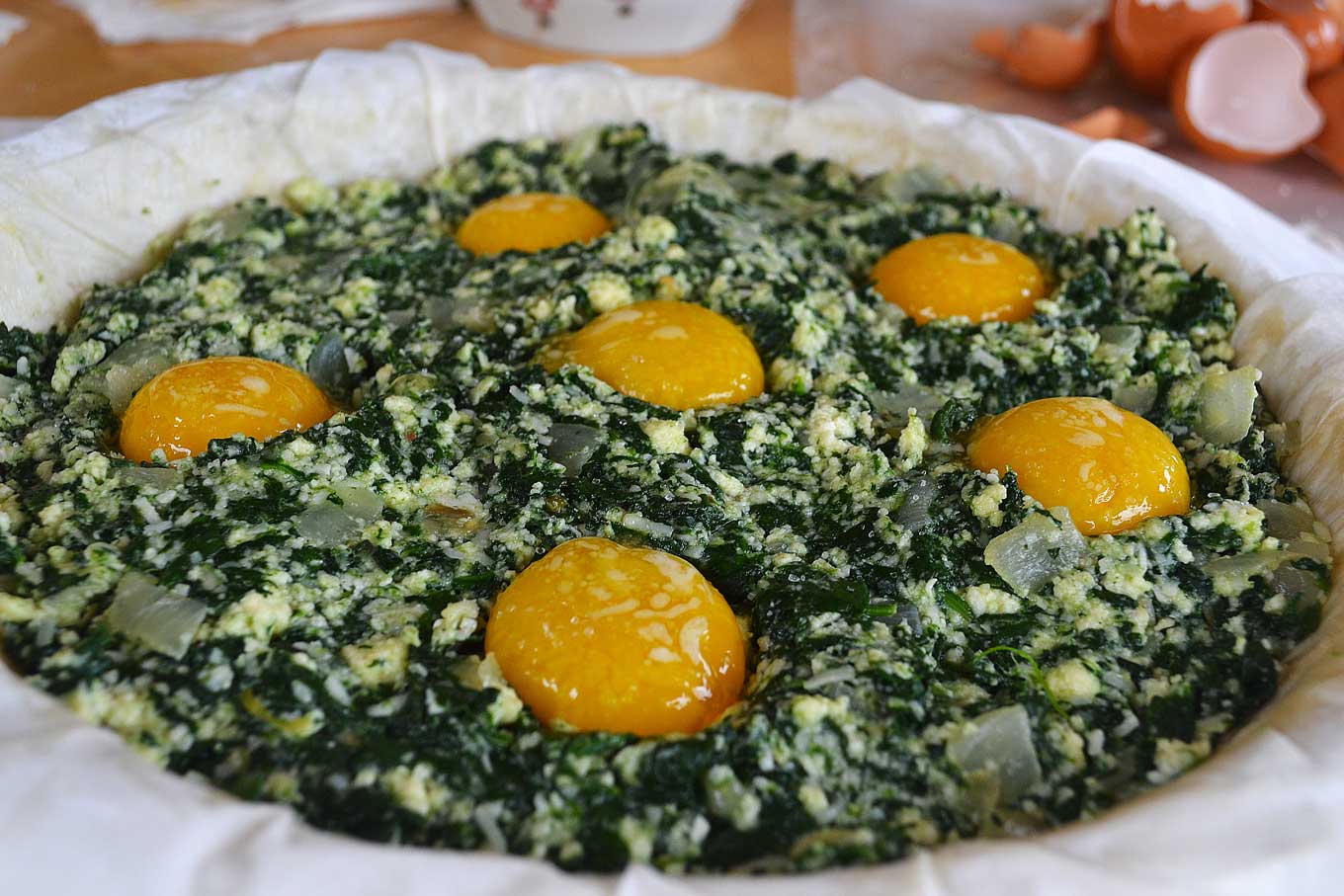
With a spoon, drop just a little bit of melted butter on each yolk, along with a little salt and pepper.
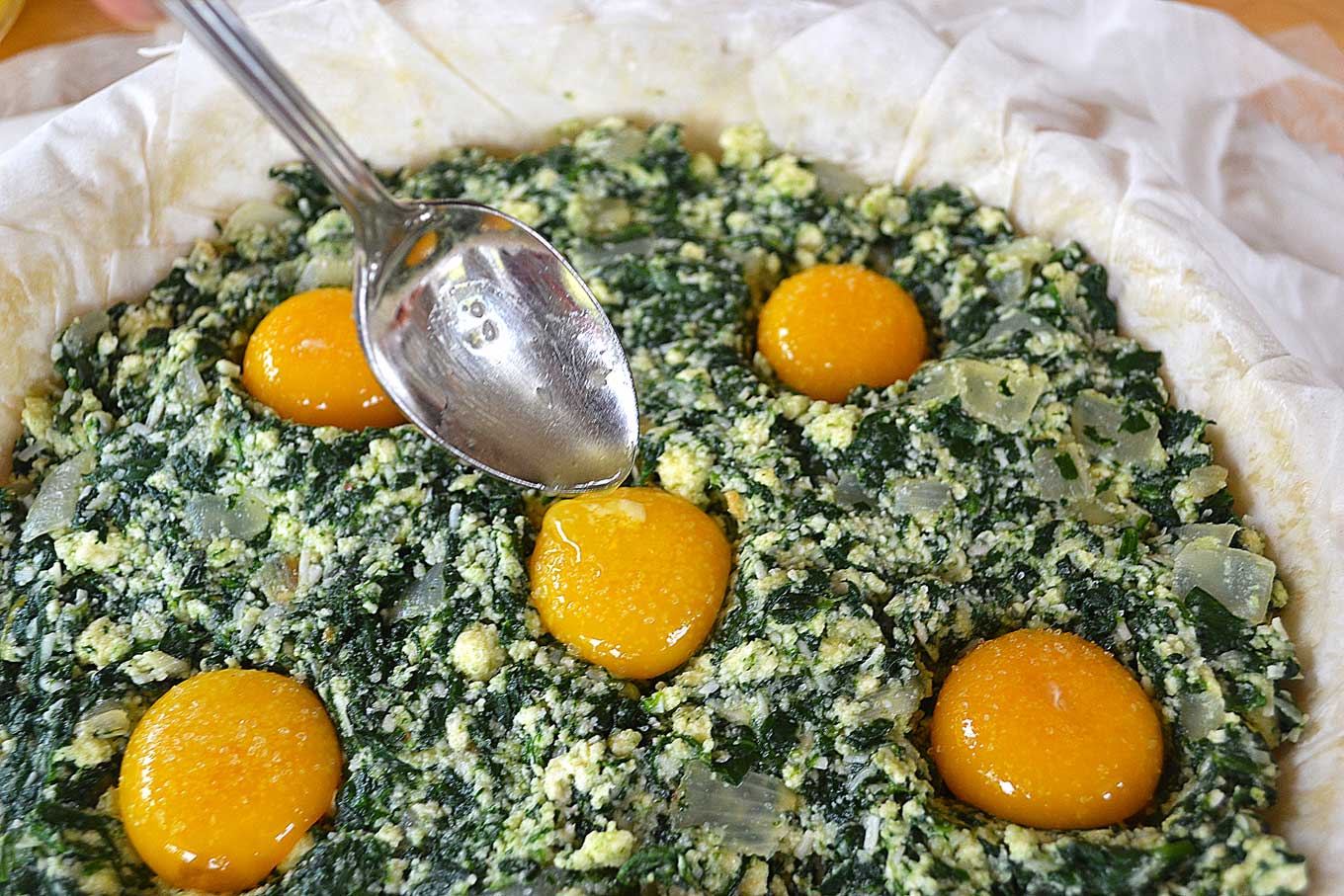
Now take the extra filo hanging over the edge of the dish and fold it over to the centre to cover the filling.

Bring each sheet of filo over one at a time and brush each one with butter.

Finally, brush the top of the whole pie with butter.

Place the pie dish in the oven and lower the temperature to 350°F. Bake for 40-45 minutes, or until the filo pastry is a golden brown. Remove and let cool slightly before slicing. Makes 8 servings.





Leave a Reply